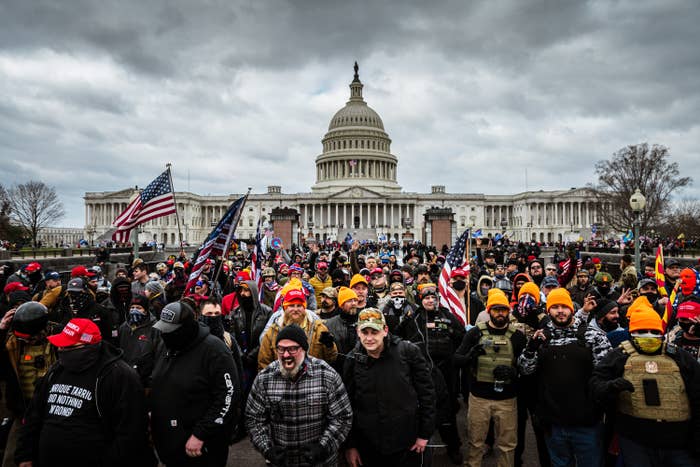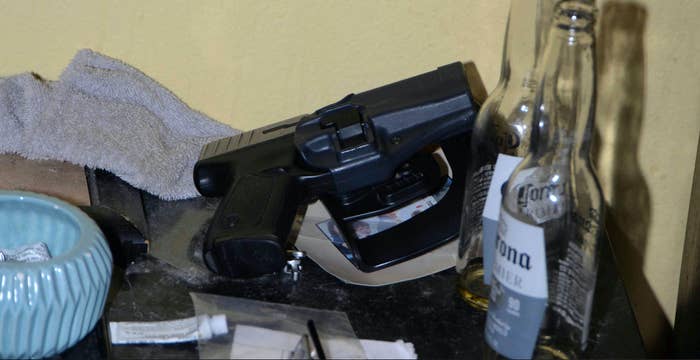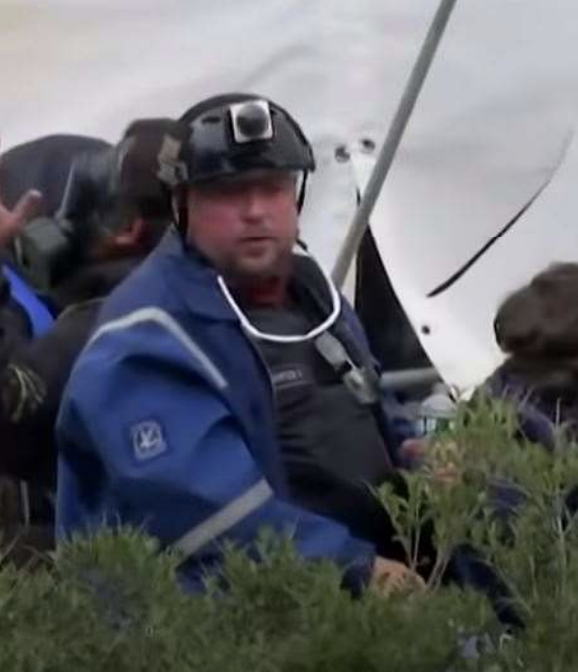
WASHINGTON — A former member of the Texas Three Percenters militant group testified Friday that both he and Guy Reffitt — the first Jan. 6 defendant to stand trial — traveled to Washington, DC, with rifles and handguns, carrying the latter with them as they made their way to the US Capitol during the insurrection.
Reffitt is facing a five-count indictment that includes charges that he brought weapons to DC to support a “civil disorder” and illegally carried a firearm onto restricted grounds at the Capitol. Proving that Reffitt not only traveled to DC with guns, but also that he brought a handgun to the Capitol, is central to the government’s case.
The jury heard Friday from Rocky Hardie, who signed an immunity agreement with the government for his testimony; the prosecutor had him explain that he understood he could still be prosecuted for his actions on Jan. 6, but the deal meant that any charges couldn’t be based on information he’d given the government or testified about as part of the agreement.
Late in the day, the jury then saw the weapons that the FBI seized from Reffitt’s house and that Hardie said Reffitt brought to Washington: a Smith & Wesson .40-caliber handgun and an AR-15-style rifle. The prosecutor showed a zoomed-in image of Reffitt’s back while he was on a stairway in front of the Capitol, and an FBI agent identified a dark object near Reffitt’s waist as a matte black holster, with a “silvery metallic linear object” that the government has alleged was the handgun.
Hardie told the jury that he lived outside of Austin and ran a business manufacturing in-ear audio devices for listening to music. He explained that he’d joined the Texas Three Percenters militant group motivated by what he described as videos he’d seen of protests where “antifa” was burning things down, breaking windows, and throwing firebombs.
Hardie said he was worried that he didn’t have people in his community who could watch his back and that he was looking for people who were “like-minded.” He said that when he joined TTP, he asked if they were racist, white supremacist, or anti-government, and was told no. Asked what the group did believe in, Hardie said they supported law enforcement and the Constitution, and they believed in supporting the government as long as it “follows the Constitution.”
During a meet-up with Reffitt at a park, Hardie said they talked about how the country was “going down the tubes” and shared a dislike of House Speaker Nancy Pelosi, referring to her as “evil incarnate.”
The prosecutor asked if Hardie believed the election had been stolen before Jan. 6. He said he did. Asked if he still believed that now, he replied, “Yes, I do.”
Hardie testified that he felt inspired by Reffitt’s Telegram messages calling on members of the TTP to go with him to Washington when Congress was due to certify the Electoral College, and they arranged to drive together. He said that Reffitt had talked about how “corrupt” people in DC needed to be “dragged out,” but Hardie said he “didn’t think it was something that anybody was going to act on.” In his mind, he said, he thought the crowd would listen to then-president Donald Trump speak and then go to the Capitol, and hopefully their presence would give lawmakers inside pause.

Hardie told the jury that he and Reffitt discussed bringing guns with them on the trip; he believed it would be for self-defense. He said they knew DC had firearm prohibitions, but he and Reffitt shared the opinion that “it’s better to be tried by a jury of 12 than carried by six,” meaning they would rather face legal consequences than die. Hardie said they each brought an AR-15-style rifle and a handgun, and that they pulled over in Virginia to put the handguns and ammunition in locked cases; they’d disassembled the rifles for the trip, he said.
The pair arrived in DC the night of Jan. 5, and the jury saw a selfie that Hardie said he took of the two of them in their hotel room; Reffitt is wearing a black shirt with “Oath Keepers Texas” in yellow writing. On the morning of Jan. 6, Hardie said Reffitt gave him a few plastic zip-tie handcuffs — to use in case they needed to “detain” people, he said Reffitt told him — and Hardie made sure they each had a working handheld radio to communicate.
As for the guns, Hardie said they each assembled their rifles and left them locked in the car so that they’d be ready if they needed them. Asked why they might need the rifles later, Hardie said they were concerned about their safety and the safety of other people, again bringing up the threat posed by “antifa.” Hardie said he carried a loaded .45-caliber handgun and extra ammunition in a shoulder holster, and he believed Reffitt was carrying his handgun on his hip.
Hardie and Reffitt walked from their hotel to the Ellipse, where the “Stop the Steal” rally was taking place in the morning. He said he listened to Trump speak “on and off,” but he couldn’t hear well and was more focused on the crowd. After the speech, the crowd moved “like a herd of cattle,” he said, and someone called for medical attention and Reffitt volunteered to help, at which point Hardie lost track of him. He said they remained in radio communication, but he didn’t see Reffitt again until they were back at the hotel later in the day.

Hardie made his way to the Capitol, saying that from a distance, the people climbing up scaffolding in front of the building looked like spiders crawling up the walls. He watched people break through the police barricade and said he got close enough to the exterior of the Capitol that he could have touched a wall. On the radio, he said Reffitt talked about trying to get inside the building, but being unable to get there after being pepper-sprayed.
Back at the hotel, Reffitt was in pain from being sprayed and shot at with projectiles, Hardie said; the jury saw a photo Hardie took of Reffitt’s bruised legs. Reffitt bragged about his confrontation with a woman police officer who was shooting at him; the jury heard earlier this week from that former US Capitol Police officer, Shauni Kerkhoff. Hardie recalled Reffitt saying that he made it possible for the rest of the crowd to go forward; the government’s theory is that although Reffitt didn’t go inside the building, he served as the “tip of the mob’s spear.”
After Hardie and Reffitt returned to Texas, Reffitt messaged a Telegram group on Jan. 10, 2021, that TTP’s state leader Russ Teer had been taken in for questioning by law enforcement. Asked by a prosecutor Friday what was going through his mind at the time, Hardie said, “Uh-oh.” Hardie said that after Reffitt sent another message that read, “Start purge of all previous conversations,” he deleted certain messages. Hardie said he decided to leave the militant group after he was visited by the FBI a few weeks after the attack.
Reffitt’s lawyer, William Welch III, briefly questioned Hardie, having him confirm that although his immunity agreement did not completely shield him against prosecution, he hadn’t been charged to date. Welch asked Hardie if Reffitt bragged. He said yes. Welch asked if Reffitt used hyperbole. When Hardie said yes, Welch asked if that happened a lot. “From time to time,” Hardie replied.
“State of alarm”
Friday began with a brief civics lesson for the jury, with a former general counsel to the secretary of the Senate, Daniel Schwager, walking through the structure of Congress and the constitutionally-mandated duties that members were fulfilling when they met in a joint session on Jan. 6, 2021, to certify the Electoral College results.
Schwager was in the Senate chamber when the Capitol was breached and identified himself in a video from that day moving to the dais area from the back of the room. When he saw then–vice president Mike Pence leave the chamber, he said, “I knew we were in a dangerous situation and that we were about to go into some protocols we had drilled on for locking down, for when the chamber was under threat.” He testified about watching US Capitol Police officers lock the doors — one smaller officer had to jump up because some of the ornate wooden doors are so large, he recalled — and how one officer stood holding a “very large” and “very long” gun.
“I was already in a state of alarm and things like that frankly comforted me because … my perception already was that we were under severe threat,” Schwager said of seeing the officer with the gun.
The second witness was US Secret Service Special Agent Paul Wade, who managed security for Secret Service protectees — like the president and vice president — when they visited the Capitol. When he arrived at the Capitol on Jan. 6, he said that he saw the metal bike rack security perimeter around the complex and thought it seemed adequate. After escorting Pence’s wife and daughter to the Senate gallery to observe the joint session that afternoon, Wade said he went to the basement but soon heard scuffling and running; he learned from officers that the building had been breached and immediately went back upstairs.
Wade testified that he stayed with the Pence family until Congress was able to resume the joint session in the evening once the building was cleared; he identified himself in surveillance camera footage that recorded the Pences’ evacuation from the Senate chamber. Reffitt’s lawyer William Welch asked Wade if he’d seen his client at all that day, and Wade said no. Assistant US Attorney Jeffrey Nestler then asked Wade if the Secret Service took emergency action because of one person’s activities; Wade said no, that it was because they were advised that hundreds of people were breaching the building.
The jury also heard from an FBI photographer who documented the search of Reffitt’s house, Karla Kennedy, and the lead FBI agent on the Texas side of the investigation, Laird Hightower. Hightower talked about seeing a tip submitted by Reffitt’s then-18-year-old son, Jackson, about his father’s plan to travel to DC — Jackson had submitted the tip online on Dec. 24, but Hightower said he didn’t see it until Jan. 6, after the crowd had reached the Capitol. Hightower met with Jackson on Jan. 11 at a restaurant, and said the teenager seemed “worried,” “concerned,” and “quiet.”
A day earlier, Jackson had taken the stand to describe the events leading up to his decision to submit the tip in December, as well as the secret recordings he made of his father after Reffitt returned home from DC. At the Jan. 11 meeting, Hightower confirmed that Jackson had turned over those recordings as well as screenshots of texts that Reffitt sent his family group chat. The agent said he took Jackson seriously, and their meeting spurred the opening of a full investigation into Reffitt.
The jury saw the handgun and the rifle seized from Reffitt’s house, the helmet he wore to the Capitol, and the plastic flex cuffs that Hardie said Reffitt brought, as well as a tactical vest filled with 22 pounds of ballistic plates, according to Hightower. The FBI didn’t take the holster they found in Reffitt’s house, so Hightower used one that was the same model that the government had purchased to demonstrate how it attached to a person’s pants and how the gun found in Reffitt’s house would fit into it.
Welch briefly questioned Hightower, including on the reliability of the video that the government had used to capture the image of what they said showed the holster on Reffitt’s waist. He also asked Hightower if Jackson had talked to him about his father’s drinking habits and about whether his father had a job.
Assistant US Attorney Jeffrey Nestler told the judge that the government expected to rest its case midday Monday. Welch said he did not intend to present any witnesses.

